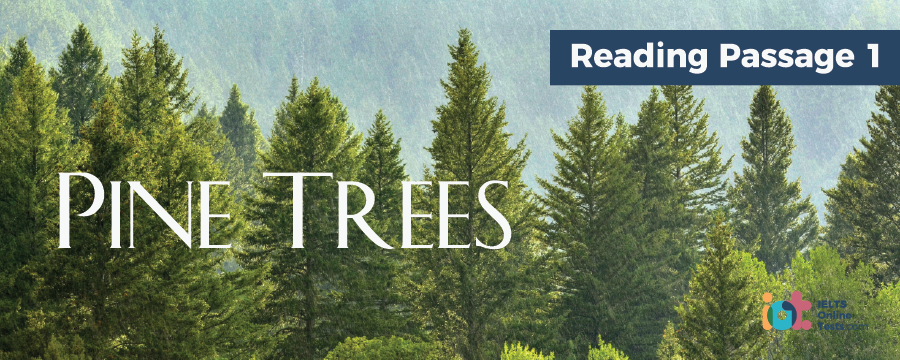
IELTS Mock Test 2021 February
- 发布时间: 21 Feb 2021
- 模考人次: 994,940
正确答案:
Part 1: Question 1 - 13
- 1 growth ring
- 2 Methuselah sprouted
- 3 (pine) cones
- 4 durable
- 5 NOT GIVEN
- 6 TRUE
- 7 FALSE
- 8 TRUE
- 9 11 A,C,D
- 12 A
- 13 D
- 1 growth ring
- 2 Methuselah sprouted
- 3 (pine) cones
- 4 durable
- 5 NOT GIVEN
- 6 TRUE
- 7 FALSE
- 8 TRUE
- 9 11 A,C,D
- 12 A
- 13 D
Part 2: Question 14 - 26
- 14 B
- 15 A
- 16 D
- 17 relevant dive time
- 18 (a) dive plan
- 19 decompression stops
- 20 guide rope
- 21 sufficient tension
- 22 one fails
- 23 equally
- 24 parted (company)
- 25 statistics
- 26 never seen
- 14 B
- 15 A
- 16 D
- 17 relevant dive time
- 18 (a) dive plan
- 19 decompression stops
- 20 guide rope
- 21 sufficient tension
- 22 one fails
- 23 equally
- 24 parted (company)
- 25 statistics
- 26 never seen
Part 3: Question 27 - 40
- 27 TRUE
- 28 NOT GIVEN
- 29 TRUE
- 30 TRUE
- 31 FALSE
- 32 high moral standing
- 33 parole officer
- 34 regulatory condition
- 35 parole violation hearing
- 36 criminal recidivism
- 37 system cracking
- 38 probation
- 39 (a) curfew
- 40 good time
- 27 TRUE
- 28 NOT GIVEN
- 29 TRUE
- 30 TRUE
- 31 FALSE
- 32 high moral standing
- 33 parole officer
- 34 regulatory condition
- 35 parole violation hearing
- 36 criminal recidivism
- 37 system cracking
- 38 probation
- 39 (a) curfew
- 40 good time
排行榜:
| # | 用户 | 得分 | 时间 | |
|---|---|---|---|---|
| Vyshnavi K |  | 9.0 | 15:19 | |
| Jakir Ahmed |  | 9.0 | 15:25 | |
| Hoa Tran |  | 9.0 | 15:26 | |
| 4 | Xuan Bach Tran |  | 9.0 | 15:27 |
| 5 | Bảo Long Ôn Khí |  | 9.0 | 15:35 |
| 6 | Jeet Patel |  | 9.0 | 15:37 |
| 7 | Pek Hieng |  | 9.0 | 15:52 |
| 8 | Rudra Parmar |  | 9.0 | 15:54 |
| 9 | Mateo Hinojosa Martinez |  | 9.0 | 15:56 |
| 10 | Azalia Trista Juliana |  | 9.0 | 16:00 |
提高雅思成绩的小贴士

How to Crack Section 1 of IELTS listening
IELTS listening section 1 is perhaps the easiest part of IELTS listening exam. The reason is that you have simple questions of form filling...
详细试卷答案解析:
Questions 1-4
Complete the sentences.
Choose NO MORE THAN TWO WORDS from the passage for each answer.
Every year, pine trees gain another 1
The pyramids were built hundreds of years after 2
Typical of all pines are their 3
The wood from pines is not very 4
- 1 Answer: growth ring
Keywords in Questions
Similar words in Passage
Q1
Every year, pine trees gain another __________
Yet mature they do, as with all pines becoming fractionally thicker every year as another growth ring is added to their truck.
Key
The keywords concerned in Q1 are every year, pine trees and gain.
From the question, we can assume that the answer should be a noun.
According to the passage, every year, pine trees gain another growth ring, which is added to their truck.
For that reason, the answer of Q1 is growth ring.
- 2 Answer: Methuselah sprouted
Keywords in Questions
Similar words in Passage
Q2
The pyramids were built hundreds of years after __________
By counting these, we can accurately state that, as of 2011, Methuselah was 4,842 years old, meaning that it sprouted as a seedling in 2832 BC, centuries before the ancient Egyptians began building their pyramids.
Key
The keywords concerned in Q2 are pyramids, built, hundreds of years and after.
From the question, we can assume that the answer should be a noun, an event or a point of time.
According to the passage, the Methuselah sprouted centuries before the pyramids were built.
For that reason, the answer of Q2 is Methuselah sprouted.
- 3 Answer: (pine) cones
Keywords in Questions
Similar words in Passage
Q3
Typical of all pines are their __________
These trees certainly have many telltale characteristics. They are evergreen, usually with needle-like foliage and a sharp pleasant 'pine smell. They are often large and imposing, with thick scaly bark, and always produce their signature pine cones
Key
The keywords concerned in Q3 are typical, all pines and their.
From the question, we can assume that the answer should be a noun.
According to the passage, all pines produce their signature pine cones.
For that reason, the answer of Q3 is pine cones or cones.
- 4 Answer: durable
Keywords in Questions
Similar words in Passage
Q4
The wood from pines is not very __________
The wood is fragrant, but prone to decay, so it is most suitable for indoor or dry carpentry, rather than outdoors, where more durable varieties are necessary.
Key
The keywords concerned in Q4 are wood and not very.
From the question, we can assume that the answer should be an adjective describing wood from pines.
According to the passage, wood from pines is fragrant, prone to decay and not very durable, meaning that it is not suitable to be used outdoors, where more durable varieties are necessary.
For that reason, the answer of Q4 is durable.
Don’t be misled by adjectives like fragrant or prone to decay, as the answer must go with the phrase “not very”.
Questions 5-8
Do the following statements agree with the information given in Reading Passage One?
Write
| TRUE | if the statement agrees with the information |
| FALSE | if the statement contradicts the information |
| NOT GIVEN | If there is no information on this |
5 Ponderosa pines are the largest.
6 Pines are familiar to most people.
7 Birds usually spread pine seeds.
8 Lightning storms benefit pine barrens.
- 5 Answer: NOT GIVEN
Keywords in Questions
Similar words in Passage
Q5
Ponderosa pines are the largest.
Pines can be small, such as the Siberian Dwarf Pine, or huge, such as the Ponderosa Pine in the wilds of Oregon, and there are over 100 varieties in all.
Key
The keywords concerned in Q5 are ponderosa and largest.
According to the passage, Ponderosa is a huge kind of pines. However, the author didn’t mention anything about whether Ponderosa is the largest or not.
For that reason, the answer of Q5 is NOT GIVEN.
- 6 Answer: TRUE
Keywords in Questions
Similar words in Passage
Q6
Pines are familiar to most people.
They have been introduced in to the more temperate portions of the Southern Hemisphere, where they are now grown widely, becoming a familiar feature in parks and gardens. It would not be too much of an exaggeration to say that almost everyone knows pines.
Key
The keywords concerned in Q6 are pines and familiar to most people.
According to the passage, almost everyone knows pines. Pines are grown widely, becoming a familiar feature in parks and gardens, which matches with information in Q6.
For that reason, the answer of Q6 is TRUE.
- 7 Answer: FALSE
Keywords in Questions
Similar words in Passage
Q7
Birds usually spread pine seeds.
As the cone opens, the seeds eventually fall out, mostly to be dispersed by the wind, or sometimes by birds.
Key
The keywords concerned in Q7 are birds, usually, spread and seeds.
According to the passage, there are 2 ways for pine seeds to be spread, the first way is by the wind and the second is by birds. However, birds sometimes spread pine seeds, which contradicts with the information in Q7 (usually).
For that reason, the answer of Q7 is FALSE.
- 8 Answer: TRUE
Keywords in Questions
Similar words in Passage
Q8
Lightning storms benefit pine barrens.
This last fact - the need for wildfires for regeneration - is another fascinating aspect of many pine species. In fire-prone areas, it can result in extensive stands of pines, a good example being in 'pine barrens'
Key
The keywords concerned in Q8 are lightning storms, benefit and barrens.
According to the passage, in fire-prone areas, it can result in extensive stands of pines, a good example being in 'pine barrens', which matches with information in Q8.
For that reason, the answer of Q8 is TRUE.
Questions 9-11
Choose THREE answers from the list, and write the correct letter, A-F, next to the questions.
Which THREE groups of people, A-F, particularly like pine trees?
- A
- B
- C
- D
- E
- F
- 9-11 Answer: A,C,D
Keywords in Questions
Similar words in Passage
Q9-11
Which THREE groups of people, A-F, particularly like pine trees?
A. Plantation owners
B. Outdoor carpenters
C. People interested in craft
D. Certain native communities
E. Factory owners
F. Users of turpentine
As these trees grow fast, can be planted in dense arrays, and produce attractive and easily moulded wood, they are favourites for commercial plantations.
The wood is fragrant, but prone to decay, so it is most suitable for indoor or dry carpentry, rather than outdoors, where more durable varieties are necessary.
In a more homely sense, perhaps what people most like are the cones, the largest of which are regularly used by children and craft enthusiasts.
Many people lament that modern manufactured toys in the more affluent of these countries have displaced cones, although some Nordic communities still teach traditional 'cone-craft' in high schools.
As for other uses of pines, their branches are valued as Christmas trees, and their wood is also pulped in factories for paper and chipboard production.
Pine resin is a byproduct, and this is collected for distillation into turpentine, an important industrial solvent.
Key
The keywords concerned in Q9-11 are three, groups of people and like pine trees.
To answer this kind of question, we can use the method crossing out the wrong options while reading.
Option A is correct because it is stated in the passage that pines can produce attractive and easily moulded wood, therefore, they are favourites for commercial plantations.
Option B is incorrect because according to the passage, wood from pines are not durable enough to be used outdoors.
Option C is correct. According to the passage, pine trees are regularly used by children and craft enthusiasts.
Option D is correct. It is stated in the passage that some Nordic communities still like pine trees and teach traditional con-craft in high schools.
Option E is incorrect. According the passage pine wood is pulped in factories for paper and chipboard production. However, there is no information about where factory owners like pine trees or not.
Option F is incorrect. Although it is stated in the passage that pine resin, a byproduct, is collected for distillation into turpentine, there is no information about the preference of users of turpentine.
All things considered, the answer of Q9-11 are A,C,D.
Questions 12-13
Choose the correct letter, A, B, C, or D.
Pine cones are
- A
- B
- C
- D
Keywords in Questions | Similar words in Passage |
Q12 Pine cones are A. complicated B. male C. mostly the same size. D. often used as toys in affluent countries. | They are often large and imposing, with thick scaly bark, and always produce their signature pine cones. These formations are certainly not simple. They can be male (small, inconspicuous, and shedding pollen) or female (large, woody, and containing seeds), even when appearing on the same tree. Pines can be small, such as the Siberian Dwarf Pine, or huge, such as the Ponderosa Pine in the wilds of Oregon, and there are over 100 varieties in all Many people lament that modern manufactured toys in the more affluent of these countries have displaced cones, |
Key To answer this kind of question, we can use the method crossing out the wrong options while reading. Option B is incorrect. According to the passage, pine trees can be male or female, even when appearing on the same tree. Option C is also incorrect. Pine trees can be small or huge, which contradicts with information in option C. Option D is incorrect. According to the passage, modern manufactured toys in the more affluent of these countries have displaced cones. Option A is correct. According to the passage, pine cones formations are certainly not simple, which matches with the information in option A. For that reason, the answer of Q12 is A. complicated. | |
Methuselah is
- A
- B
- C
- D
Keywords in Questions | Similar words in Passage |
Q13 Methuselah is A. 4,842 years old. B. the oldest tree ever. C. visited by tourists. D. not subject to much sunshine. | By counting these, we can accurately state that, as of 2011, Methuselah was 4,842 years old, meaning that it sprouted as a seedling in 2832 BC, centuries before the ancient Egyptians began building their pyramids. In 1964, a student was taking a coring sample from another bristlecone pine in the area. His coring toll broke, so the tree was cut down to allow dating by an examination of a cross-section of its trunk. Upon doing this, to the astonishment of all, 4,844 rings were counted, signifying that the tree was even older than Methuselah. That's one reason why we keep the location of Methuselah a secret. This tree is precious, and must be kept free from all human interference. |
Key To answer this kind of question, we can use the method crossing out the wrong options while reading. Option A is incorrect. It is stated in the passage that Methuselah was 4,842 years old (in the past), which doesn’t match with information in Q13 (Methuselah is 4,842 – at present). Option B is also incorrect because another tree is said to be older than Methuselah. Option C is incorrect. It is stated in the passage that they keep the location of Methuselah in secret, free from human interference. Option D is correct. The phrase “not subject to much sunshine” is used figuratively to say that the location of Methuselah is a secret. For that reason, the answer of Q13 is D. not subject to much sunshine | |
Reading Passage 1
You should spend about 20 minutes on Questions 1-13, which are based on Reading Passage One.

Pine Trees
I am looking at a very thick twisted trunk, rising to medium height, at which point appears a stumpy canopy of spiky needles. It's a tree, but a very special one. Ron Simonson, a park ranger explains. "It's a bristlecone pine, and it's been given the name, Methuselah". I ask the obvious question, and Ron replies, "Because like Methuselah from the bible, this tree is very old, one of the oldest living things on Earth in fact." I ask the next obvious question, and Ron replies, "Basically Methuselah has existed throughout virtually all of recorded human history." I look again at this quiet and unassuming tree, beginning to realise it is worthy of great respect.
Being in a cold climate, facing limited summer seasons, rooted in nutrient poor and dry soil, and subject to high winds and withering winters, bristlecone pines mature very slowly indeed. Yet mature they do, as with all pines becoming fractionally thicker every year as another growth ring is added to their truck. By counting these, we can accurately state that, as of 2011, Methuselah was 4,842 years old, meaning that it sprouted as a seedling in 2832 BC, centuries before the ancient Egyptians began building their pyramids. And that's just one fascinating fact about that well-known species of tree - the pine.
Pines trees are native to most of the Northern Hemisphere. Several species have adapted to the harsh conditions of high elevations and latitudes, including Methuselah himself, growing among the peaks of the White Mountains of Northern California.
Pines can be small, such as the Siberian Dwarf Pine, or huge, such as the Ponderosa Pine in the wilds of Oregon, and there are over 100 varieties in all. They have been introduced in to the more temperate portions of the Southern Hemisphere, where they are now grown widely, becoming a familiar feature in parks and gardens. It would not be too much of an exaggeration to say that almost everyone knows pines.
These trees certainly have many telltale characteristics. They are evergreen, usually with needle-like foliage and a sharp pleasant 'pine smell. They are often large and imposing, with thick scaly bark, and always produce their signature pine cones. These formations are certainly not simple. They can be male (small, inconspicuous, and shedding pollen) or female (large, woody, and containing seeds), even when appearing on the same tree. They have numerous scales arranged in a spiral, with seeds (on the female) tucked within. As the cone opens, the seeds eventually fall out, mostly to be dispersed by the wind, or sometimes by birds. In some varieties, the cones remain closed until their binding resin is melted by forest fires.
This last fact - the need for wildfires for regeneration - is another fascinating aspect of many pine species. In fire-prone areas, it can result in extensive stands of pines, a good example being in 'pine barrens'. These are eco-regions of sandy nutrient-poor soil dominated by pines, since the frequency of natural (usually lightning-induced) fires weeds out the less fire-tolerant species. It is perhaps sad that modern fire prevention methods have resulted in the decline of many pine species in the wild, and most ancient pine barrens are now being taken over by other forest vegetation.
However, the situation is very different for home and commercial use, which has seen pines become a very common sight. As these trees grow fast, can be planted in dense arrays, and produce attractive and easily moulded wood, they are favourites for commercial plantations. The wood is fragrant, but prone to decay, so it is most suitable for indoor or dry carpentry, rather than outdoors, where more durable varieties are necessary. As for other uses of pines, their branches are valued as Christmas trees, and their wood is also pulped in factories for paper and chipboard production. Pine resin is a byproduct, and this is collected for distillation into turpentine, an important industrial solvent.
In a more homely sense, perhaps what people most like are the cones, the largest of which are regularly used by children and craft enthusiasts. With the widespread distribution of pines across the Northern Hemisphere, cones form part of the many traditional cultures there, where they are used for decorative purposes, fire starters, bird feeders, or just intriguing natural playthings for young children. Many people lament that modern manufactured toys in the more affluent of these countries have displaced cones, although some Nordic communities still teach traditional 'cone-craft' in high schools.
For some reason, I always come back to Methuselah. Ron tells me a story. In 1964, a student was taking a coring sample from another bristlecone pine in the area. His coring toll broke, so the tree was cut down to allow dating by an examination of a cross-section of its trunk. Upon doing this, to the astonishment of all, 4,844 rings were counted, signifying that the tree was even older than Methuselah. Ron smiles wryly at the thought. 'We deliberately killed the oldest life on Earth. That's one reason why we keep the location of Methuselah a secret. This tree is precious, and must be kept free from all human interference.'






